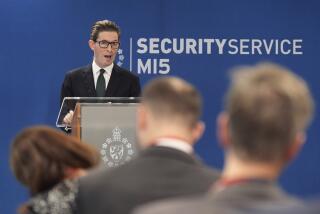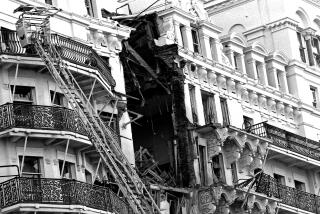Documentary : IRA Is a Move Ahead in Deadly Terrorism Game : After the bombing death of British legislator Ian Gow, Scotland Yard officials concede that there is little they can do to prevent the next incident. And they say the latest campaign in the longstanding war has just started.
- Share via
LONDON — Deep inside the innocuous glass-and-chrome office tower off St. James Park, through the fifth-floor situation room, past the scores of wall trophies honoring Scotland Yard’s finest, and beyond the thick set of steel doors and hidden surveillance cameras at the end of an unmarked, unadorned corridor lies the awful truth for Britain’s ongoing war against terrorism.
It is here, in the computer banks and intelligence files of Scotland Yard’s secretive anti-terrorist unit, that the mounting mosaic of Irish Republican Army bombings and armed attacks that have made headlines this summer throughout Britain and Europe combine to form a simple yet foreboding picture of the future:
The war--or perhaps more accurately, the latest campaign in a decades-old struggle by the IRA to drive Britain out of Northern Ireland and unite the province with the Irish Republic--has only just begun.
Since January, the IRA’s current campaign of bombings and assassinations has claimed 36 lives and injured scores more in dozens of attacks from Belfast to West Germany. The IRA has struck almost at will in the heart of London and at the very core of Britain’s ruling elite. It claimed responsibility for demolishing a private supper club of Prime Minister Margaret Thatcher’s Conservative Party just around the corner from Scotland Yard in June, then for blowing a hole in the side of the London Stock Exchange, and finally for killing one of Thatcher’s closest personal friends in the devastating July 30 car bombing of Conservative Party legislator Ian Gow.
“Very simply stated, we expect them to try again,” said one senior investigator in the Yard’s counterterrorism division who asked not to be identified by name. “It will be similar to the Ian Gow attack in impact but different in the nature of their target.
“They’re very versatile, and, at the moment, quite desperate. Their backs are up against the wall. Time and politics are working against them. And, frankly, they’re pretty good at what they do. They’re professional, and they’ve got a lot of experience. Keep in mind, they’ve been going for 20 years now.”
They have indeed. In the decades since the young men and women of the Provisional Irish Republican Army declared war on Britain in their fight for independence, the IRA has become one of the world’s most sophisticated terrorist organizations.
Although the guerrilla army enjoys some significant grass-roots support in the province, its actual numbers are surprisingly few. Cmdr. George Churchill-Coleman, who heads Scotland Yard’s anti-terrorist squad, estimates that there are no more than 200 hard-core IRA operatives throughout the region, and just a dozen or so operating on the British mainland at any given time.
As in any guerrilla war, though, the size of the force is not nearly as important as its conviction and expertise. And no one knows that better than Churchill-Coleman.
A 30-year veteran detective at Scotland Yard, the commander has been Thatcher’s point man in the war on IRA terrorism during the five years that he has headed the anti-terrorism unit. Although his image appears on television screens throughout Britain each time the IRA strikes, the commander is an intensely private man, and, given his added concern for secrecy, Churchill-Coleman has turned down more than 150 separate requests for press interviews.
The Yard did, however, permit a Times reporter to visit the fifth-floor command center that has become something of a war room in Britain’s campaign against the IRA this year, and to interview one of the unit’s key strategists. It was here, by analyzing the IRA’s present makeup and tactics, that intelligence experts concluded that this summer’s attacks are only the beginning of a wave of IRA violence likely to grow far worse before it subsides.
“They’re running a sustained campaign right now,” the strategist said. “All they’ve really done so far is put down two or three devices once every week or 10 days. And they’re doing a pretty good job of it. The Ian Gow killing, for example, made a big impact. He was a man of stature, a man who didn’t fear anyone and, as a top opponent of the IRA, Ian Gow was a legitimate target in their mind.
“They won one there, I’ll give them that. But those are damned hard things to prevent.”
Indeed, the IRA is known to operate in small, tightly controlled cells, and, although the identities of its hard-core members are known to Scotland Yard, none have been caught with sufficient proof to make a strong enough case to convict in court.
“We know who they all are, but they’re extremely clever, and they’re constantly learning from us, constantly trying to keep a step ahead,” the officer said. “They research us all the time. They’re looking to see how we achieve arrests. When we make an arrest, the whole objective of the defense attorney is to find out how we made our case, how we gathered our evidence, how we used informants. And then, the next time they strike, they change their methods accordingly to keep outpacing us.”
Still, Scotland Yard’s strategy is a methodical one that combines increasingly aggressive intelligence gathering with meticulous sifting of physical evidence--that, combined with the constant hope for good luck and timing. Since the summer bombing campaign began in earnest last June, he has issued instructions to all beat police officers throughout London to be more aggressive and alert.
“We’re pushing very hard to make everyone alert within the department, because these people (IRA operatives) are not going to be caught by computers or other gadgets. They’re going to be caught on the street, so that’s where we have to look for them,” the Scotland Yard strategist said, quoting the commander.
The IRA hunters have also made a major effort to enlist civilian aid in their search. A hot line set up soon after the bombs started going off early this year already has yielded 600 calls, some of which have contributed to ongoing investigations. “All it really takes is one call, if it’s the right one,” he added.
But even the Yard’s key strategists concede that, in the current campaign, which represents a marked shift for the IRA from military to largely civilian targets, there is often little the police can do until after an attack.
Experts on Northern Ireland and the IRA say the summer campaign has two principal goals: to gain publicity and to derail talks scheduled for this fall between the British government and rival political groups in Northern Ireland. Veteran IRA-watchers like David McKittrick, the Belfast correspondent for The Independent, a London daily, said that the Gow killing was an attempt to accomplish both by staging a spectacular event that could “drive a wedge between the British and Irish Republic governments.
“They would most like to see the introduction of measures which they could characterize as repressive, and which might produce a counter-reaction among nationalists in general.”
So far, though, that hasn’t happened, leading Scotland Yard’s strategists to believe that similarly devastating attacks are more than likely in the coming weeks and months.
“In a strange way, we’ve been sort of lucky with the crisis in the gulf,” the Scotland Yard analyst said. “It’s dominated the headlines to such an extent that the IRA knows that even they cannot compete--no matter how big a splash they make.
“But, when those headlines start dying down, you can safely wager the IRA will steal them right back again.”
More to Read
Sign up for Essential California
The most important California stories and recommendations in your inbox every morning.
You may occasionally receive promotional content from the Los Angeles Times.












